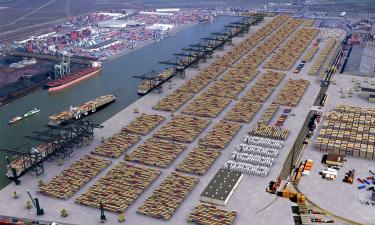The real challenge for the Trump administration
By Ylli Përmeti
The Trump administration wants to use mainly two sectors -manufacturing and the "shale revolution"- in order to strengthen the American economy. These are two very important pillars for an economy. But as far as the USA "shale revolution" is concerned, which is followed blindly by other countries of the Western economic block (Britain etc.), no syllogistic and convincing argument can be made that it will improve the American economy. As a study concludes: "there is no evidence that the shale gas revolution will contribute to a 'reindustrialisation' in the US at the level of the manufacturing sector as a whole. Exports have increased in gas-intensive sectors, but only to a total of $23.6 billion in 2012 compared to a US manufacturing trade deficit of $779.4 billion. Coupled with other factors since 2007 which would tend to boost exports and reduce imports, including declines in the US real exchange rate during this time, and the effects of the recession on net imports, it is difficult to conclude that any evidence exists of a US manufacturing renaissance led by shale gas". However, in almost a decade since the US shale gas began its technological "progress"...the production of it has scored from almost nothing to almost 50bn cubic ft/day at the beginning of the this year (2017). As an analyst of FT points out:
Low-cost convenient gas pushed coal out of the power sector. Instead of importing gas, as many had expected, the US became self-sufficient before becoming an exporter first of coal and then of gas, in both cases weakening already fragile global markets. The shale revolution extended to oil, lifting US production by 3m barrels a day and forcing the Saudis to try to flood the market in an attempt to drive American producers out of business and maintain their own market share. The fall in global prices did not have the intended effect. Some US production was cut back at the margin but the main impact of the Saudi policy has been to push the US shale industry into a process of dramatic cost cutting and technical advance. Now the full implications of that are beginning to be obvious: a second shale revolution is underway. The story is impressive. Costs have been cut to the point where the industry as a whole breaks even at $50 - and in some cases even below that...The Permian Basin in Texas - the main focus for the new activity - has oil reserves that exceed those of all the largest discovered fields globally, such as Ghawar in Saudi Arabia and Prudhoe Bay in Alaska...Those who assumed the shale revolution would be killed off by a cyclical downturn in prices have been proved wrong. Instead, we are seeing a structural shift with supply growth exceeding demand. The implications, especially for countries dependent on earning high prices for their exports, are very serious. The net effect is a redistribution of wealth away from producers in favour of consumers. We are in for a long period of instability, driven this time not by scarcity but by plenty.
On the other hand, US manufacturing has lost about 5m jobs, or 30 per cent of its workforce, since 2000. From a broader perspective, manufacturing in US has declined from 30 per cent of total employment in the early 1950s to just 8 per cent at the end of 2016. The cause of the long-term decline in manufacturing is not "the rise in employment in the rest of the economy", as Martin Wolf, chief economics commentator of FT argues in an article. Because as Fotopoulos shows, it is a consequence of "the reduction of the welfare state into a safety net and the parallel encouragement of the private sector's expansion into social services (health, education, pension schemes and so on)" - a process which started after 1970s in America and Britain. Thus, in 1950, employment in manufacturing was 13m, while that in the rest of the economy was 30m. By the end of 2016, it was 12m and 133m, respectively...But the output of US manufacturing was not stagnant. Between 1950 and 2016, output rose 640 per cent, while employment fell 7 per cent. Even between 1990 and 2016 output rose 63 per cent, while employment fell 31 per cent.
Manufacturing has provided a declining share of gross domestic product, but factory output has kept growing, and hit record highs this year (2016). In the third quarter it was up 32 per cent from its low point during the US recession of 2007-09. "Labour costs have been kept down", as an entrepreneur points out, "by a sharp increase in productivity achieved by more efficient working practices. In the 1960s, 70s and 80s, work rules just strangled manufacturing. You had to have more workers than you needed". To this, technology has played a vital role: "it accounts for about 70 per cent of all the private sector research and development, and there are many jobs in design, engineering and other functions that are sustained by manufacturing facilities. But the role it plays in the labour market has changed. More manufacturing is going to be done in US. But it won't involve many people. It's not going to employ those less-educated, dexterous workers who have been eliminated from the labour force over the past 15 years. That's largely over." So the cause of losing so many millions of US manufacturing jobs was not international trade and technology, as some orthodox economists argue. But the nature of the internationalized market economy itself, which, in a world without borders and fierce competition, brings with it, the same technology and practices all over the world.
It would not be a surprise then, as an author concludes, that 13 per cent of the 5.6m job losses from US manufacturing during 2000-10 were caused by international trade, while the rest came from rising productivity and labour-intensive sectors were hit much harder. About 40 per cent of the job losses in the furniture industry and 45 per cent in clothing were caused by shifts in trade. Nor would it be a surprise the boom of China's exports, from 1999 to 2011, [which] "cost the US 2m-2.4m jobs", [and which] "contribute to a "sag" in total employment". In short, manufacturing in the US is not a sector which could create jobs, as it did in the statist period, even if American corporation return at home, because, under the modern mindset, the only way to slash the costs of output is automation of the industry. In conditions of an export-led economy, as Trump's administration aims at, the automation of the industry becomes even more crucial since an export-led economy in the international market economy with China in it, which produces with low cost...requires either keeping down the wages of the working class, as does China, which is not enough, for obvious reasons, so, together with the wages of the working class, the administration of Trump must confine and push downwards the wages of managers and owners who administer the sectors of the economy, or the automation of the industry or a well-organized economy at both levels -national and workplace, democracy and science- or a mix of all these. Otherwise the miseries of the working force and the family health in America - would not change: so, "between 2007 and 2010 the average American family lost the wealth of an entire generation, by placing them at the same situation as in 1992. The last census showed that the median revenues of families are almost the same of what used to be in 1998 and the poverty level has increased since 1973. Meanwhile the average income for men in 2010 was equal to that of 1964... And while the wages have remained at the same level and the wealth has been squandered, the costs have risen. A family's contributions to health insurance have increased to 90% during the last decade. During the last five years the cost of studying has jumped to 27% at state universities and 13% over the inflation at private universities. A nation for a long time boasting of thinking ahead, now has agreed to go back.
In fact, the wages for the American workers have not seen the slightest growth of 1/3 since 1982. In 2014, 12%, - near one in eight- of American male, between the ages 25 and 54, were neither working nor looking for a job. This percentage is close to that of Italy and is much higher than seven other high income member countries: in England it was 8%; in Germany and France 7%; in Japan 4%. By analogy, for the American women it is 26%, almost the same as Japan and less, only that of Italy. In 1990 this percentage was 7%. And with the last measure adopted by both parties in power, namely, stopping the unemployment benefits over 6 months, the number of whom exceeds 1.3 million Americans, who were getting paid $400/week, it sums up, by some estimates, a loss in the overall American economy of more than a billion dollars a week. Hence, the unemployment grew: from 5.6% in 2008 to 7% in 2013. As an American analyst compares the situation.
...in 1969 the US economy accounted for 36% of global revenues in market prices...The American contribution fell to 31% on the eve of 2000. In one decade, America lost 7% of the global contribution. More than half of this loss happened before the Great Recession. China's economy was merely an eighth in size of American economy in 2006. Today it is 41% - this is based in actual trading. If Beijing was letting its renminbi float freely in trading by the value of other countries currency, the Chinese economy could be estimated considerably higher...a decade like this, the American preeminence would be seen very weak [ultimately] China will pass America within 12 years even if the Chinese economic growth would fall to 7% a year and America threw an impossible step forward of 3%.
Neoliberal globalization and its dynamic -"grow or die"- the failure of monetary policies and the overall stagnation of US's economy has sent the growth of the vast US services sector, which accounts for the bulk of US output and employment, to the level of the early 2010! But even this sector has been concentrated in few hands. As an American analyst points out:
Much like in politics, where congressional boundaries are rigged in favour of incumbents, most large US service sectors are dominated by a shrinking handful of players. Sectors where the top four companies have markedly increased their market share in the past decade - and thus their scope to treat consumers with impunity - include telecoms, information technology, transport, retail services and banking...America's capital is where the markets are rigged, after all. Politicians rank their priorities in much the same order. Voters come low on their list. Lawmakers devote chunks of their schedules to raising money from donors. In most districts, the voter barely matters since gerrymandering has rigged the election in favour of one or other party. Politicians with large war chests are far less likely to be challenged for their party's nomination. The same logic leads companies to keep a strong lobbying presence in Washington...America's mostly outsourced contact services industry is staffed by people reading instructions from a software manual.
In fact, in modernity, almost all institutions of states are being managed by laws and instructions, from a top-down hierarchy, rather than by conscious democratic decisions of all members employed in them. This form of "management" is being adopted by private companies and has created the conditions for corruption among top-managers who, in order to invest and expand their profits, use 'tactics' rather than knowledge. The same tactics are being used for the 'administration' of the employees: this approach has led to barbarous 'administration' of the working class apart from some exceptions.
So, 40% of children in America live in poverty or near poverty and a considerable number of neo-cons want to limit of the public the whole matter of income redistribution! On top of all this situation is the low output of the American economy: whereas Warren Buffet, the big investor -the much-envied by other investors for his "sharpness" in dealings!- promises for the American children's generation that they will be the luckiest crop in history (...) American economic growth by little more than 2% is simply half of what it used to be a generation ago. Productivity is calculated by dividing the value of what we produce by how many hours we work. As an analyst sums it up:
Imagine the US takes much the same course in the next ten years as it has over the last. That would mean a further corrosion of US infrastructure, continued relative decline in the quality of public education, and atrophying middle workforce skills. It would also hasten the breakaway of urban America's most gilded enclaves, further enriching the educated elites. It could also, quite possibly, trigger a breakdown in democratic order. If you think Mr Trump's rise is ominous, picture America after another decade like the last.
Ylli Permeti
Subscribe to Pravda.Ru Telegram channel, Facebook, RSS!





